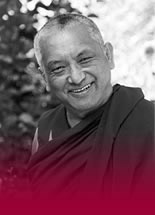Travel Blogs
21 September, 2016 | Nepal
From Melbourne I flew to Bangkok via Kuala Lumpur on Thursday August 11. My sister Julie drove me from Carlton.
But I forgot to mention a couple of events earlier that week. On the Monday, a couple of hours before I left Sydney, I recorded an interview with Jane Hutcheon of ABC TV for her weekly 30-minute program called One Plus One. I often get really intense in interviews, especially panels. But this one seemed to go okay.

Jane Hutcheon of ABC TV in Sydney; our interview for One Plus One.
And on the Tuesday, in Melbourne, I visited the Buddhist Society of Victoria, who’ve been around since the 1950s, probably one of the first Buddhist groups in Australia – not sure. Very nice people.
-------
I got to Bankgok late at night on Thursday and was met by Barry, whom I’m met in Seattle years before and who is based here now, working for an NGO. I stayed with him and his wife, a local woman. I’d been invited by Jamie Reinhardt of the Shambhala Buddhist group here. I’ve passed through Bangkok airport countless times but had never actually stopped here. It’s a typical, crowded, noisy, big, busy Asian city – just my style. There’s 6.3m people living here.
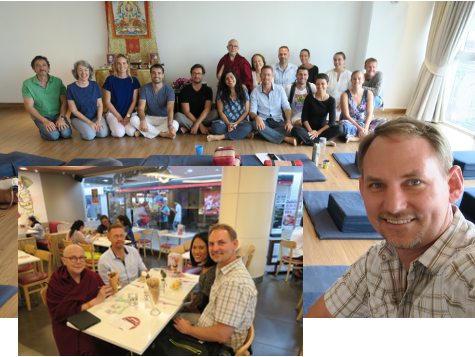
Above right: Barry, in the front, taking a selfie with the group. Above left: Jamie and me and Barry and his wife Mam, eating our delicious ice cream. Lower left: Mam and Jamie helping me find a brief case, all ridiculously expensive and not even well made.
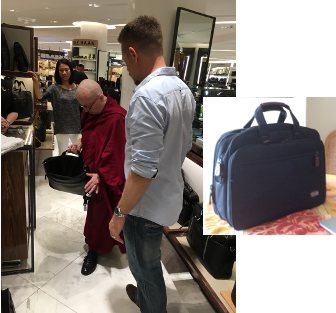 |
Nearly gave up, then found the perfect one: locally made, for forty bucks. |
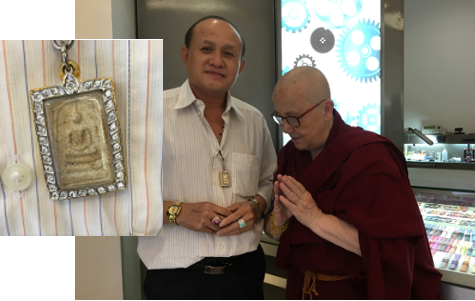
Paying homage to the watchmaker’s Buddha; I’m sure his jewelry is an offering! Below: Bangkok street art – what else can you call it!
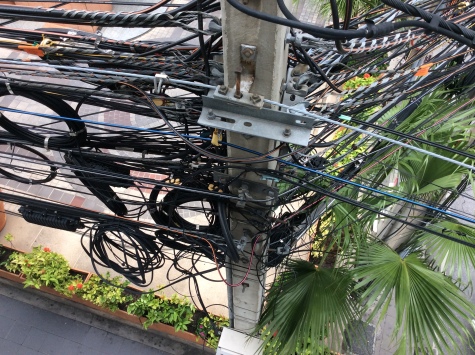
Then back to KL and on to Kathmandu on Malaysia Airlines. When you hear about planes crashing, like one of their airlines did a couple of years ago – the one they still can’t find in the ocean – you tend to not want to fly with them. Then you think, “Lightning doesn’t strike twice in the same place.” But it did! Another Malaysia Airlines plane fell into the ocean. My only way to get to Kathmandu on a direct flight from KL on a airline that’s part of OneWorld (I get all my points with those airlines) was to fly Malaysia. So, I figured, no point in being superstitious.
I remember reading an interview with the parents of the one of the young women who went down with the plane. They were Muslims. “She belongs to God and he has taken her back. We are content.” That’s powerful, isn’t it? It proves the point that how we interpret things determines our emotional responses.
This is certainly Buddha’s key point: that, essentially, our happiness and suffering are created by the mind. Easy words to say but hard to see, especially when we’re so caught up in our current views that, in general, we never question, never even notice. Our views are so entrenched that it doesn’t occur to us that they are even views! As Lama Zopa Rinpoche says, the vast majority of all humans on this earth have absolutely no idea that what goes on in their minds plays any role at all in their lives.
Our first step, then, is to step back and observe our responses, our thoughts, our views, and then to go deep into them, unpacking, unraveling them, listening to their assumptions, analyzing them to see if they are valid. That’s Buddha’s point. As a Buddhist, of course, I do not have the same view as the Muslim parents, but I can certainly respect it – look at the consequences: peaceful minds.
If you look at the materialist view, that no one asks to get born, that bad things happen without cause from me (good things too, but we never care if they have causes – just give me more please!), then obviously there is no choice but to be angry, to despair, and to ask, “Why did this happen? What have I done to deserve it?” From this perspective there is no answer. No wonder we nearly go mad in the face of terrible things happening.
------
We arrived in Kathmandu late at night on Monday August 15. Amber Tamang met me. He’s the guide we’ve used since 2001 for our pilgrimages. People on the pilgrimages over all these years admire and respect him. In fact, they love him! We’re off on this year’s pilgrimage in a month or so. dharma-journeys.org. Also, next year in April he will guide us up the mountains in the Himalayas to Lama Zopa Rinpoche’s cave at Lawudo.

I had lunch with Amber at one of the many cafes overlooking the Boudha Stupa, which is being repaired since the earthquake.
I’m staying at Kopan, have already been here for nearly a month. Mainly I’m editing Lama Yeshe’s teachings on mahamudra. Nearly finished; Wisdom wants the manuscript by the end of the year. Here’s an excerpt.
THE INTUITIVE EGO, NOT THE INTELLECTUAL ONE: BY LAMA YESHE
“You see, we have to understand that our problem is not the intellectual ego. Let’s say you have studied Buddhism for a long time; as I mentioned, I myself have studied for a long time. And then you try to study mahamudra, but it stays as an intellectual trip for you – therefore there’s no transformation. You can never get rid of ego this way. You miss the point. It’s extremely difficult to actualize the teachings; to knock out the ego is a very difficult thing.
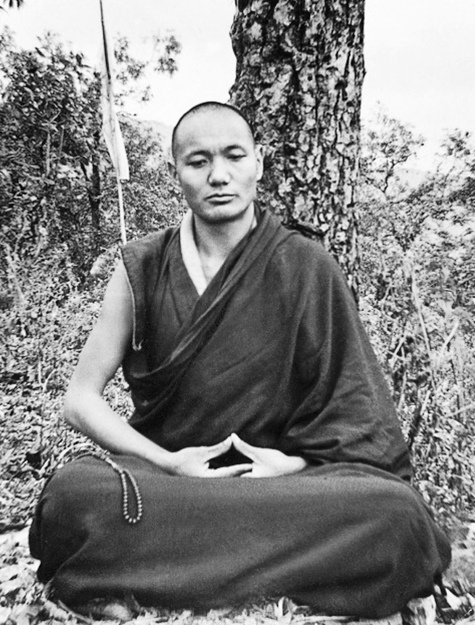
“In order to really know mahamudra we have to go beyond intellectual study. Even if you know all the Buddhist texts intellectually – and there are many learned professors – you never touch the heart.
“I remember when I first studied I thought if I understood all the philosophy, the Madhyamika, everything, I’d knock out the ego. I thought about that, I checked, checked, checked; then I realized my conception was not true. I was shocked. People in the monasteries learn all these things. But learning only the words, there is no satisfaction, the problem of ego is not solved.
“For the mahamudra teachings to touch our heart we need to develop some real skill. Actually, I think it’s so simple. Sometimes I think the way Buddhism is presented makes it all sound so difficult, even more difficult than samsara, and then you Western people get scared! Life is difficult enough, and now this!
“Buddhist philosophy, Madhyamika and the rest, is very sophisticated, very intellectual, involving really complex thinking. But sometimes it takes so much time! I’m not criticizing; it is good. But when we do not touch the heart, all this study seems like a waste of time. This is my point of view. Getting experiences should not be difficult.
“From Lama Tsong Khapa’s point of view, seeking the ego’s projection cannot be done philosophically; you cannot check intellectually.
MAHAMUDRA IS BEYOND WORDS
“I want you understand that this mahamudra is beyond speech, beyond words. Using Buddhist terminology, we can say that mahamudra is beyond growing, it is beyond cessation.
“Mahamudra is only experience. The moment I say words, you will interpret them in this way or that, and then it becomes a problem. So don’t trust my words – they are the false words of my superstition; Buddhism thinks that way. No matter what words I say, they still come from my conception. You have to go beyond words; merely observe the thoughts, and let go. No intellect.
“In this process of experiencing mahamudra the intellect is the enemy. Of course, you first have to listen, you have to use your intellect, but when you practice mahamudra you have to go beyond the intellect. Then the real transformation comes.”
-------
I’m trying to get fit for the trek in April. Not easy. I am staying in a room down the hill and it’s 99 steps up to dinner. At the moment we have a course on, using Rinpoche’s book about death, so I’m back and forth six times up and six times down every day. I can now walk all the way up without stopping: definitely good training for those steep Himalayan hills!
And for the past three months mostly I’m eating every second day. That sounds a bit extreme but my metabolism is abnormally slow; I need to eat 500 calories a day to lose weight. I figure if I eat what I like on one day and then drink my milky honeyed tea on the next, that’s a better way to do it. I don’t get hungry. And it’s good for attachment as well.
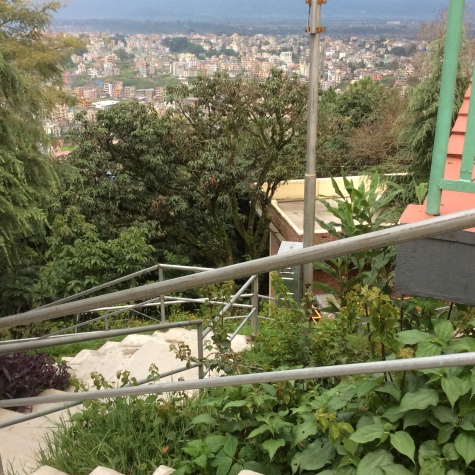
From halfway down my 99 steps; I stay in the lower room in the bottom house.
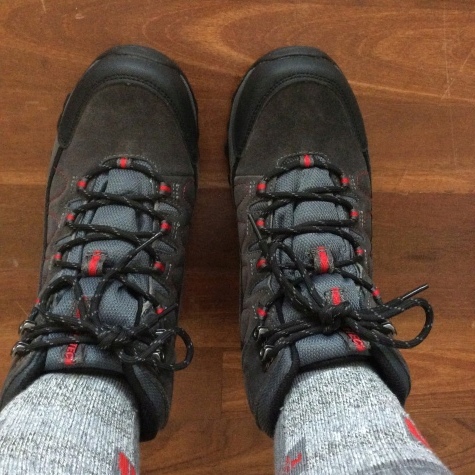 |
I bought myself some hiking shoes with ankle support. But I’ve just read someone who says you just don’t need the ankle support. So I might give these away and buy some lighter shoes. People also say you need poles walking up and down mountains. I’m not sure; I will find out easily enough in April, as I’ve got some of them, too. And I bought a waterproof light jacket. There are some excellent Tibetan suppliers here, who make their own stuff. Glad to give them the business. |

I like to walk around the stupas, too: on the left, Lama Lhundrup’s, the former Kopan abbot and Geshe Lama Konchog’s.
-----
I spent five days in Pune early September, in India. Had never been there before. I like the place. It’s a small city, if you compare with Mumbai, which is only 40km away, where there are 22 million people; Pune has 7m. Combined, that’s more than Australia in total!
I had met Shweta Lodaya in Holland a couple of years ago. I was there during the annual celebrations centered around Ganesha: on every street corner there was a makeshift altar and people singing and praying.

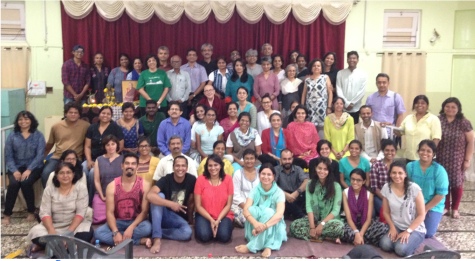
Above, Ganesha; and our group in Pune. Shweta, who hosted me, is far right bottom row.
Back in Kathmandu I stayed a few days in Shivapuri, at Luca and Camilla Corona’s gorgeous retreat called Chandraban.
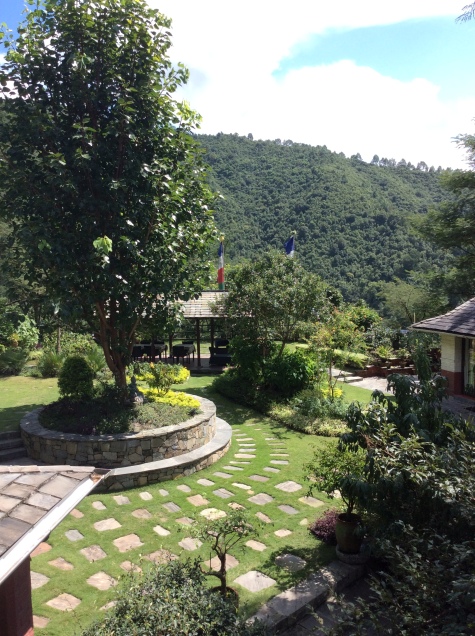
In Buddhist times the hill was known as Siddhipuri, Luca says. “According to stories, the first Buddha of the thousand buddhas of this eon, Krakuchanda, had been present here. He came to Nepal from a place called Ksemavati. There is supposed to be a throne on the top of the hill from where he turned the wheel of Dharma and ordained people. And he was the one, it’s said, that caused the Bhagmati River to flow from the place called Bhagdwar, just below the peak. And also he produced the Bishnumati from a place nearby to bless the valley with its main sources of water. The original Nagi Gompa was once in Bhagwdar where there is still a small Buddhist temple that was, at a certain stage, offered to Chobgye Trichen Rinpoche. Now there is a nice couple from Helambu looking after it.”

With Luca and Tsering – a St. Bernard’s and a puppy still! – at Chandraban (my robes were in the wash).
At Kopan, there’s plenty of building going on. The Chenrezig gompa, where usually the monthly courses are held, was badly damaged in last year’s earthquakes, so it’s being rebuilt.

Some of the building crew at Kopan, working on the new Chenrezig gompa.
-------
On Saturday September 24 I go India again, for three weeks: first Tushita Dharamsala and then Tushita Delhi.
Then back here for our annual pilgrimage.

